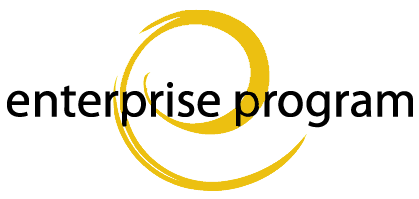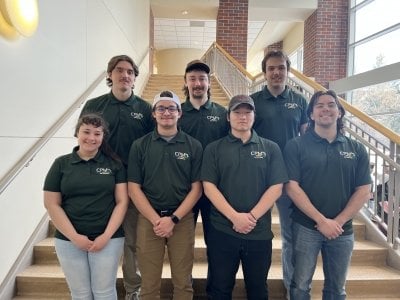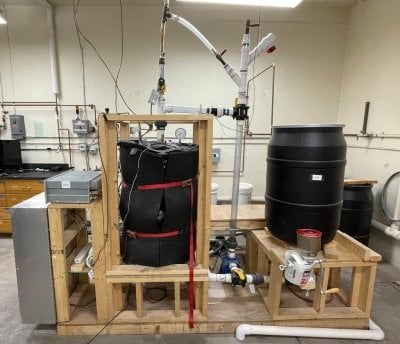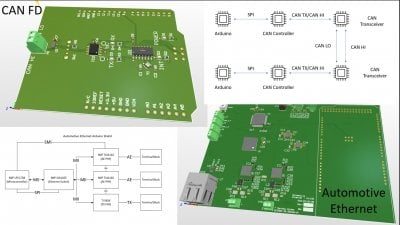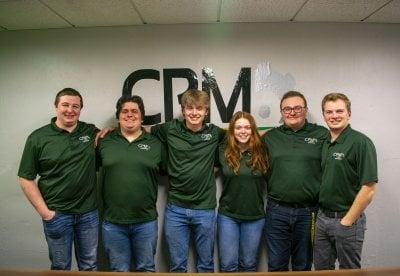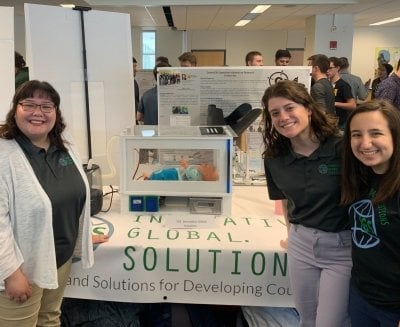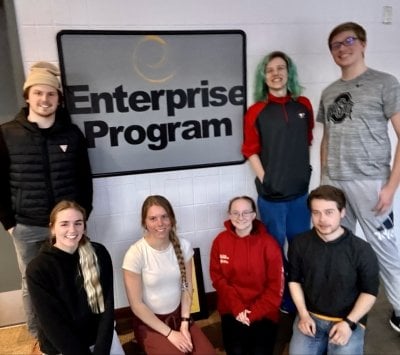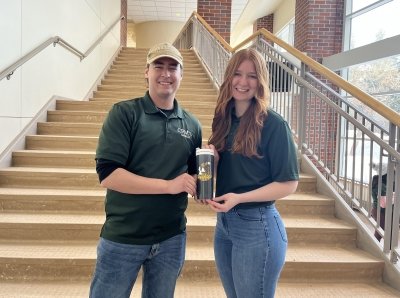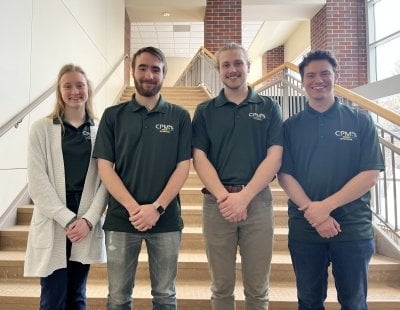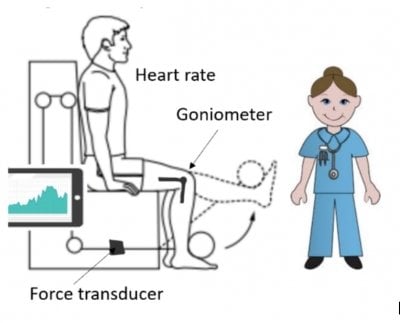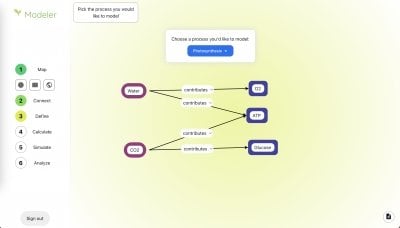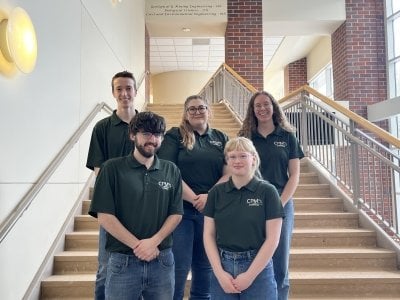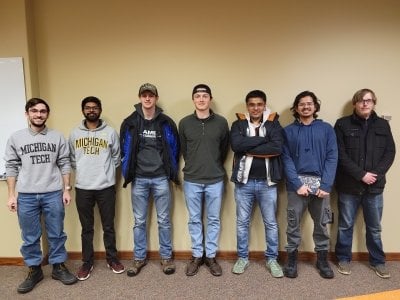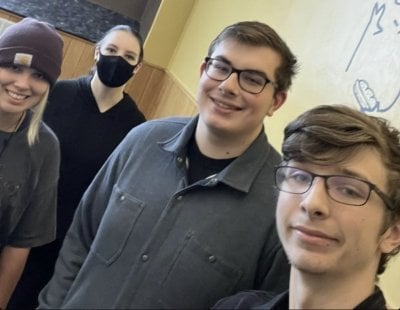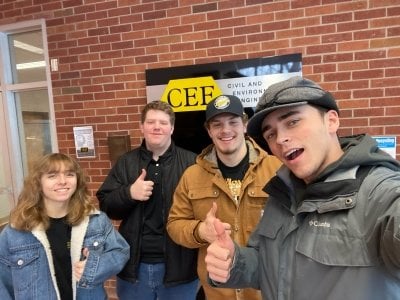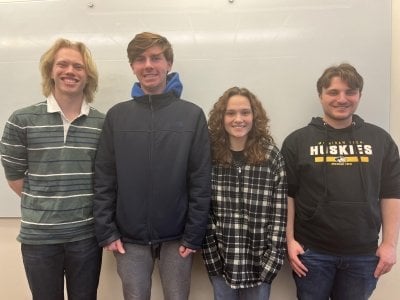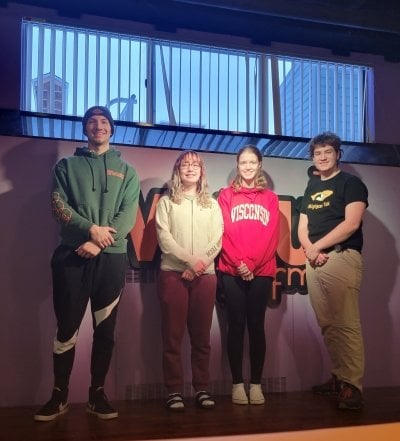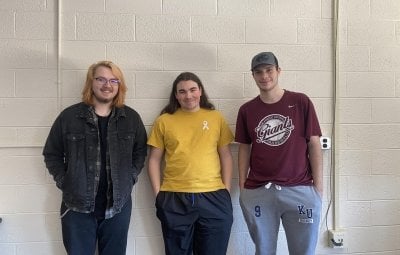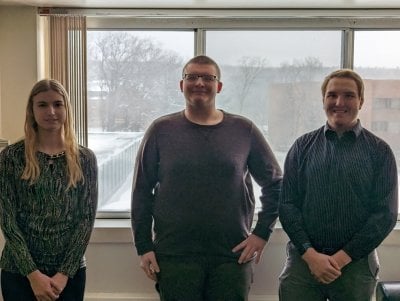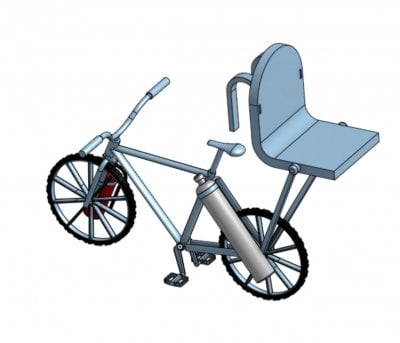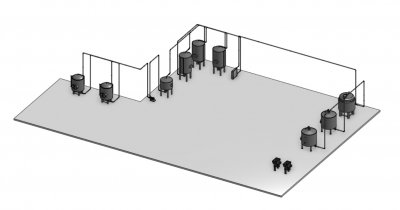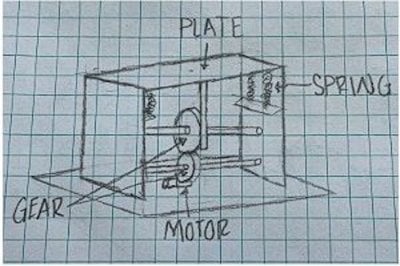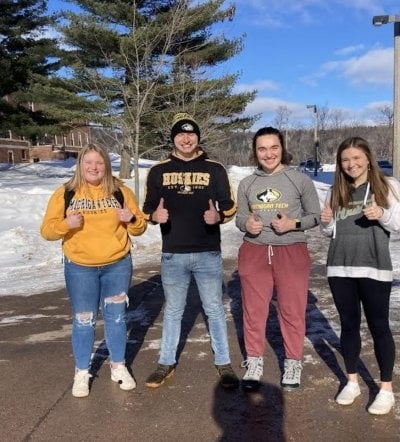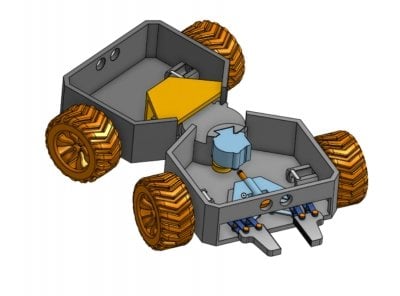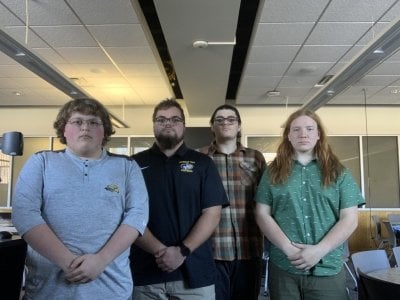301. AAA [Affordable, Accessible, Authentic] Prosthesis
The AAA [Affordable, Accessible, Authentic] Prosthesis project is designing ankle and foot prosthetics that are mechanically simple for amputees in developing countries. The ankle design’s main objective is to function similarly to a human ankle by replicating its articulation. This is done by using a bolt pattern which guides the ankle design in its side to side movement. The foot design’s main objective is to maximize rollover efficiency by designing a curved foot to provide rollover efficiency while maintaining a simplistic design. This year our focus has been on fabrication and testing. The data received from this year’s tests will tell us how much downward force our designs can handle before failure, along with the rollover efficiency of our designs.
302. Biogas: Anaerobic Digestion of Dining Hall Food Waste for Methane Production
The objective of the Biogas project is to determine if the anaerobic digestion of dining hall food waste is an economically feasible way to produce energy for Michigan Tech. Through the process of anaerobic digestion, or bacteria breaking down organic material in the absence of oxygen, methane is produced which can be burned similarly to natural gas. Using this process reduces the amount of greenhouse gas emissions and cuts waste management costs. The leftover organic material, called digestate, can be used as a fertilizer throughout the community. This year, the team's focus has been on implementing a programmable logic controller (PLC) to automate the system, updating the job safety analysis (JSA), and running data trials to determine methane production.
303. CAN FD and Automotive Ethernet Learning Modules
The goal is to create low-cost learning modules for both Automotive Ethernet and CAN FD. These modules will be used to emulate modern automotive ECUs communication with sensors and actuators.
Currently the CAN FD learning module has been completed, which is an Arduino Shield with a full software library written to support communication. The Automotive Ethernet learning module is still in the prototype phase. This phase will involve hardware validation and the creation of a software library to facilitate communication between two or more modules. Off-the-shelf Automotive Ethernet solutions are usually cost prohibitive to be used for educational purposes. To our knowledge, our Automotive Ethernet module is the first of its kind to be low cost.
304. Commercial Viable Keg Cleaner - CPM Enterprise
The Commercially Viable Keg Cleaning project is one of the Consumer Product Manufacturing (CPM) Enterprise team’s seven current projects. The project goal is to create a commercially usable keg cleaner for small-scale breweries. Currently the project is in the prototype stage, and features a programmable logic controller (PLC) which allows the cleaner to be run semi autonomously. This allows breweries to focus manpower in other areas while their kegs are being cleaned. At the completion of the project, the prototype will be tested in order to see how effectively the unit cleaned the kegs. If the bacteria testing comes back positive, the project will be open sourced and will allow for more breweries to deliver clean and ready kegs for their process.
305. Innovative Global Solutions: Low Cost Low Power Infant Incubator
The goal of this project is to create a low-cost, easy to assemble/disassemble and easy to clean infant incubator that can be made available throughout the world. For the device to be effective and improve the health of the infant, the device needs to regulate temperature and humidity. In addition, there needs to be adequate ventilation within the incubator to prevent suffocation of the infant. These environmental conditions will be monitored by sensors and controlled by PID (Proportional-Integral-Derivative) controllers. The vitals of the infant must also be monitored. The vitals that are going to be recorded are body temperature, heart rate, and SPO2 (oxygen saturation). Consideration will be made for storing and accessing data from these measurements. The device also needs to be fully enclosed to prevent bacteria and illness from entering the incubator environment and to allow for proper regulation of temperature. Inside the incubator a seamless interior would be incorporated which would be easily sterilized. This device needs to be FDA and IEC compliant to allow for the device to be marketable and manufacturable in the future.
306. Miiboo: A Human-Following Industrial Assistant for Seamless Task Support
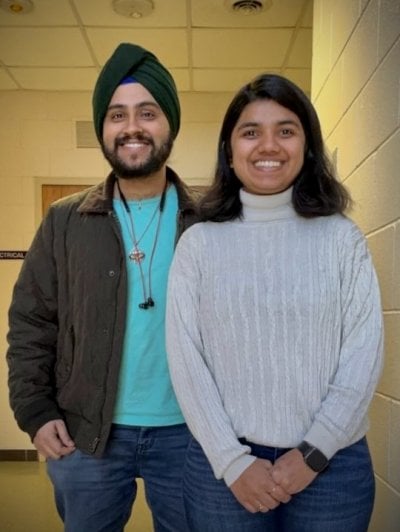
The project aims to create a QR code-based system that allows robots to assist humans with various industrial operations by autonomously following the assigned human and carrying tools and goods. The system will include a QR code reader, a mobile robot, and a human-machine interface, with safety features to ensure the safety of both the human and the robot. The project will involve significant research and development in pattern recognition , robotics, and human-machine interaction and has the potential to revolutionize industrial operations, increasing efficiency, productivity, and safety.
307. Modular Prosthetics
The objective of this project is to design, fabricate, and test a low-cost modular below the knee prosthetic with full functionality and accessibility. This project was chosen because current below the knee prosthetics are still highly expensive, uncomfortable, and time consuming to manufacture. Currently, the team is working on a 3D pressure mapping system using sensor technology to identify areas of high pressure within the prosthetic's socket. Additionally, the team has dedicated time to researching biocompatible materials, past prosthetic designs, and regulations surrounding prosthetics.
308. Multi-Use Beverage Container – OneTumbler – Phase 2
Sponsored by Sussex Injection Molding from Sussex, WI, the OneTumbler Sustainability team in the CPM Enterprise aims to encourage sustainability on Michigan Tech’s campus through promoting a multi-use beverage container made from recycled plastic. The team’s goals are to generate awareness and investigate new market opportunities for the OneTumbler product line. The high-level approach to achieving greater levels of sustainability at Michigan Tech is through reducing the amount of single-use beverage containers on-campus. The main objective of this academic year is to provide OneTumblers to all incoming students living in on-campus housing. The OneTumbler is printed with a unique QR code and locally-sourced design to provide event advertising and comprehensive resources that students may need throughout the semester.
310. ORG Chem Group Heat Transfer Fluids
Sponsored by ORG Chem Group from Evansville, Indiana, the goal of this project is to update a market heat transfer fluid (HTF) to increase its lifespan of 3 to 6 months by decreasing the speed at which it degrades. A HTF is used in industry when energy needs to be efficiently transferred from one system to another. This application is at high temperatures and exposed to air which increases the speed of degradation. Increasing the lifespan of this HTF will allow consumers to save money by not having to buy the product as frequently. The final goal of this project is to obtain a HTF that will last 2 to 3 years before it is necessary to be replaced.
311. Quantitative Analysis of Knee Recovery
The goal of the project is to provide physical therapists with a way to quantitatively assess the recovery of the knee and surrounding muscles following a surgery. The purpose of this is to standardize treatment between different physical therapists and eliminate the subjectivity involved in their assessments. The team is currently working to model a housing for sensors, and create a GUI to display for the physical therapist.
312. Teaching Computational Thinking via Modeling in STEM Classrooms
The goal of the project is to develop a modeling tool for teaching computational thinking in K-12 STEM classes. Our central hypothesis is that students engaged in computational modeling and simulation in a science course are learning and applying computational thinking skills. Modeler is a web based application, built with the technologies that are currently the top standards used in the industry. Modeler has been created with users in mind and is highly focused on accessibility, ease of use and teaching outcome. Project is currently in its last phase, consisting of backend development and database integration.
313. Waste Reduction, Recycling, and Reuse Solutions for Painting Processes used in Ceiling Tile Manufacturing
Our project is sponsored by the CertainTeed L’Anse Production Facility, who specialize in manufacturing mineral fiber and acoustical ceiling panels. Within the manufacturing process, ceiling tiles are coated with a layer of paint on all sides, each within their own booth. The wash up water and paint from each booth flow together through a single pipe that is pumped out to a series of settling ponds. Our project is focused on finding a method to separate the paint solids from this waste stream so the water can be reused within the process. This year, our focus has been looking into the viability of inexpensive mechanical filtration systems, such as filter cartridges and hydrocyclones.
314. AME Lear Corporation Project
Lear Corporation specializes in automotive wiring harnesses. We are specifically looking into the crimping process on the harnesses and exploring ways to accurately run FEA simulation on the process.
ENGINEERING FUNDAMENTALS
401. Avalanche Rescue Robot Prototype
The purpose of our project is to create a prototype of a possible autonomous avalanche rescue vehicle to test at scale in the snowy environment of the UP. Our goal is to find a balance between safety, speed, and efficiency in locating and extracting avalanche victims. This project is in the early stages development, with the aim of testing several ideas at a small scale to get more real world data before further stages of development.
402. Collection of Rainwater through Gutter Redirection System
The goal of the Collection of Rainwater through Gutter Redirection System, is to develop an affordable, eco-friendly, and legal manner of collecting rainwater that allows the homeowner to sit back and not do anything while their land is being hydrated and they collect usable water. We use an Arduino and various sensors or motors to redirect the water through the actual gutter system. We are currently have an entire 3-D prototype completely dimensioned and designed, ready to be printed and tested, but we are still in the early steps of our final product.
403. Fermentation Station
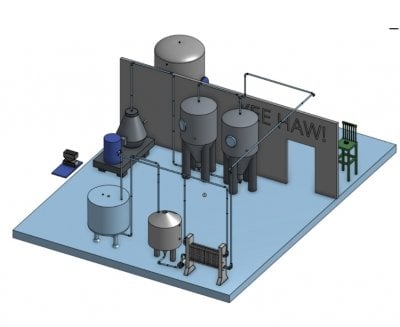
The Fermentation Station is a hypothetical future brewing company the team's mission is to create a fully modeled brewing company based off of information provided. The final product will be created in OnShape and presented on a computer with a MATLAB Code that calculates a scale up from our homebrew recipe. Arduinos are implemented to indicate what stage of the brew process our beer is in at during a given time Additionally, mapping out yearly sales and costs to create a financial plan to ensure our company is successful in its endeavors. All of this will come together during the final project at the design expo where we will demonstrate our knowledge and abilities gained throughout the semester.
404. Keweenaw Area Treats Microbrewery Consulting
Keweenaw Area Treats Microbrewery Consulting is a student project team in the ENG 1102 “microbrewery” course. As a team we have learned how to develop business plans and compare different financers, design business-oriented floor plans, develop project management Gantt charts on both a macro and micro scale, use both CAD and modeling software to create our brewery and simulate the brewing process. We also learned how to develop unique branding and concepts for our brewery, taking inspiration from the Belgian Lambic beers to create fruit-based beers using plants native to our very own Upper Peninsula.
405. Medical Emergency Device and Inpatient Call System
Our project goal is to redesign the nurse call system for the modern era. We are going to leverage the connectivity of the world through phones as well as combine older systems that still use remotes. Both would be updated so that nurses can then prioritize calls that come in based upon their signaled severity, ranging from mild to severe. Currently the scale model is being designed and the application and software to run the server is in the process of being coded.
406. Midnight Circuitry Brewing CO.
Our project was to begin a small brewing company that fulfilled three different types of alcohol: Hops, Lagers, and Ales. We designed a brewing site that includes semi-functional to-scale equipment along with a seating area, office, and bathrooms in On Shape. Furthermore, our Project Deliverables allowed us to connect each piece of equipment via pipeline and each part was functional in regards of mate simulation. We also deliberated on formulae to model the growth and decay of yeast with alcohol in fermentation and implemented said models into a code in Matlab to simulate the brewing process to a good degree of accuracy.
407. MOLLY - The Accessible Mower
The goal of the MOLLY project, is to create an open source, and handicap accessible, landscaping robot. This project is targeted primarily to assist and enable the disabled and impaired so that they may maintain self sufficiency in their own home, without dependence on outside services or more expensive alternatives in autonomous landscaping solutions, that are not suited to their needs. The handicap accessibility design factors include, easy to swap blades with limited hand mobility, brightly colored large interfaces, and simple and light construction to maximize the users capacity to move and maintenance.
408. Motor Assisted Rescue Bike
The Motor Assisted Rescue Bike is designed to rescue an injured person on a single track trail. This team created a CAD model of the project and ran simulations on the forces that would be applied to the vehicle. As trail racing becomes more popular injuries on single track trails are increasing. This vehicle will be able to rescue victims on terrain inaccessible by four wheelers or cars.
409. Nature Alchemy Brewing Company
The goal of the Nature Alchemy Brewing Company project is to model the process of starting a 10BBL brewery from both the technical and business side. Our team has developed a business plan to open a brewery with a restaurant attached to serve our customers in a variety of ways. Our brewery plans to brew exclusively organic beer with natural flavors and have an inclusive food menu that is friendly for people with dietary restrictions. For the project, our team has designed and modeled state-of-the-art brewing equipment using Onshape and we have used our models to create a full floor plan for our business. We have also developed a MATLAB program to scale up homebrew beer recipes to 10BBL.
410. Road Power Pressure Plate
The goal of our group's 1102 project is to provide a new hidden method of renewable electricity generations. The main purpose of the project is to hide a power generation system underneath existing roadways in high traffic areas to convert gravitational potential energy created by traffic into electrical energy. The project will be in a prototyping stage that will have a scaled down 3D printed replica of the final product. In short, it will contain a pressure plate supported by springs that, when pushed down, spins a mini AC motor via a gear system.
411. "Superior-S" Trail Rescue Concept
A stranding, a situation in which someone needs auxiliary help to escape from, is unfortunately common when it comes to hiking, climbing, and off-trail exploring, with the odds only increasing with age. Severe injuries and even death can accompany a stranding so the goal of "Superior S" is to create a semi-modular vehicle that can be adapted to multiple scenarios for both on and off the trail rescues. The project is currently in its first phase, having begun 3D visualization of the concept.
412. Offroad Exploration Robot
The goal of the Offroad Exploration Robot is to create a simple robot that can maneuver through tough terrain, record its surroundings, and pick up small objects. Our robot can be used for search and rescue or other police applications. Features include a central steering design to help its mobility, quad motors for the most possible power, and a front claw for retrieving objects. This project is for ENG 1102.
413. Dirty Quaff ENG1102 Microbrewery design
Our goal was to create replications of real life brewery equipment using CAD software and then placed them in a floor plan that we designed. Next, we picked a recipe for homebrewing beer, that we then scaled up to a full size batch. After that we then coded a mock program for running our brewery. Throughout these steps, we wrote memos in order to communicate the process with our instructors as if they were investors, customers, or banks.
